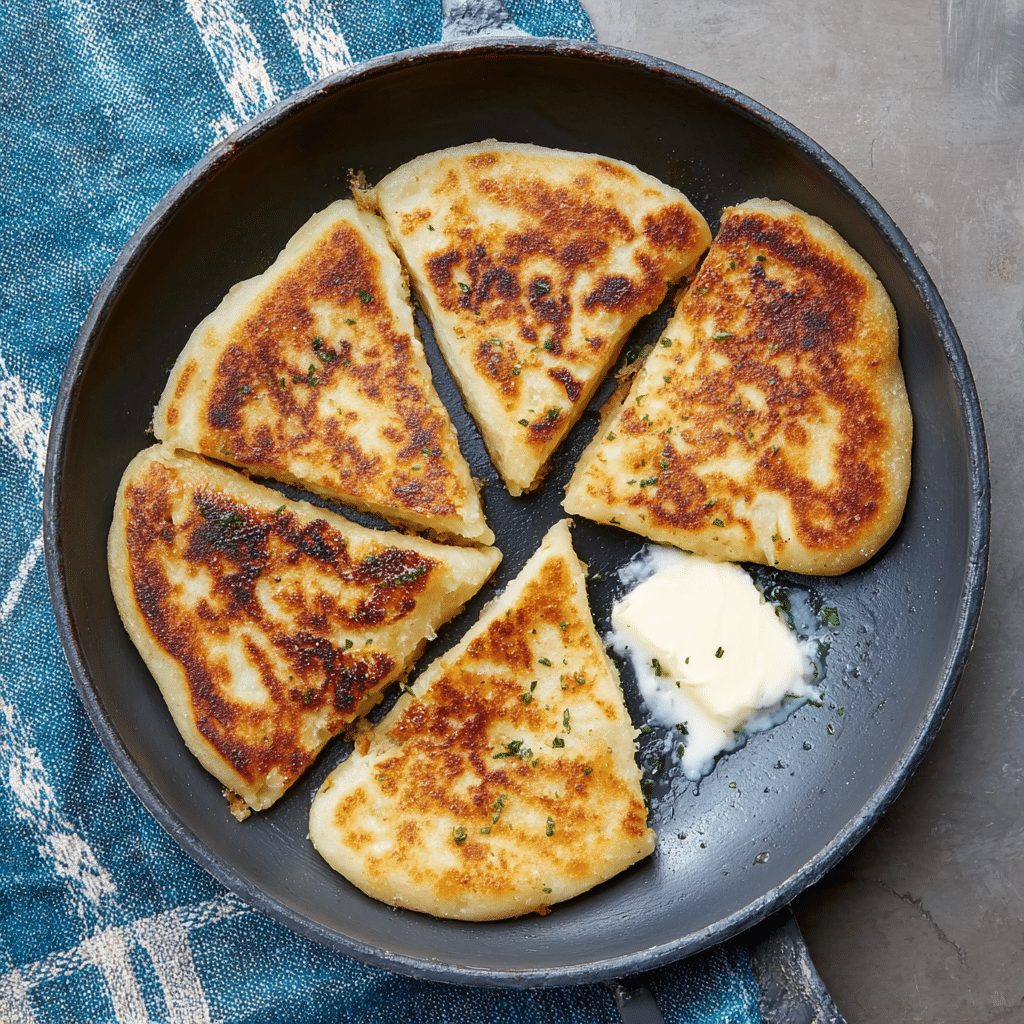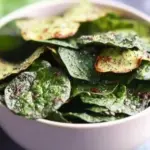The Irish Potato Farl is a cherished staple from the heart of Ireland’s home kitchens. Soft and warm on the inside with a golden, griddle-crisp outside, this dish captures the simple comfort of traditional Irish breakfasts.
Made with just a few humble ingredients, potato farls are incredibly versatile. Serve them as part of a hearty fry-up, toast them with butter, or enjoy them on their own. This age-old recipe is easy to whip up with leftover mashed potatoes, making it the perfect thrifty and satisfying addition to your breakfast or brunch table.
Full Recipe
Ingredients:
-
2 cups (about 1 pound) mashed potatoes (cooled)
-
1 cup all-purpose flour (plus more for dusting)
-
1/4 teaspoon salt
-
2 tablespoons butter (melted)
Directions:
-
In a large bowl, combine the mashed potatoes, flour, salt, and melted butter. Mix until a dough forms.
-
Lightly flour a work surface and turn the dough out. Gently knead until smooth but not overworked.
-
Roll the dough into a circle about 1/4 inch thick.
-
Cut the circle into quarters (farls).
-
Heat a non-stick skillet or griddle over medium heat (no oil needed).
-
Cook each farl for 3–4 minutes per side or until golden brown and slightly crisp on the outside.
-
Serve warm with butter, eggs, or your favorite breakfast items.
Prep Time: 10 minutes | Cooking Time: 10 minutes | Total Time: 20 minutes
Kcal: 210 kcal | Servings: 4 servings
A Taste of Irish Tradition: The Potato Farl
Potato farls are a beloved staple of traditional Irish cuisine, deeply woven into the culinary history and daily life of Ireland. Often associated with Ulster Fry, a popular breakfast in Northern Ireland, farls are simple in construction yet packed with hearty comfort. They reflect the frugal ingenuity of generations past, transforming leftover mashed potatoes into something warm, crispy, and satisfying.
“Farl” comes from the Gaelic word “fardel,” meaning a quarter. This name refers to the way these breads are traditionally shaped—rolled into a circle and divided into four equal wedges before being pan-fried. The technique dates back centuries and was especially popular in rural Irish homes where open-hearth griddles were commonly used. The result is a unique potato bread that’s soft and fluffy on the inside, golden and slightly crisp on the outside.
Cultural Significance of Irish Potato Farls
More than just a breakfast component, Irish potato farls are a symbol of sustenance and resourcefulness. In a country where potatoes were historically a dietary cornerstone, learning to utilize every scrap of leftover mash was essential. From this necessity came a wide array of potato-based dishes, and farls are among the most enduring.
Today, they remain a culinary heirloom—cooked and passed down in family kitchens, taught by parents and grandparents, and served not only at breakfast but also during traditional celebrations, holidays, and family gatherings. Whether used as a side for hearty meats or topped with butter and jam, farls bring a deep sense of comfort and nostalgia to the table.
Modern Versatility and Everyday Use
Despite their roots in old-world cooking, potato farls are incredibly adaptable to modern lifestyles. They’re easy to prepare with ingredients most people already have on hand—mashed potatoes, flour, salt, and a bit of butter. They can be made ahead of time, frozen, and reheated, making them a great option for meal prepping or feeding a family on a budget.
You can serve them as a base for poached or fried eggs, layer them with smoked salmon and crème fraîche for a brunch dish, or pair them with sausage and beans for a hearty Irish-style meal. Some even enjoy them with a smear of cream cheese or peanut butter as a snack. They fit just as comfortably on a breakfast plate as they do in a lunchbox or on a dinner table.
Texture and Flavor Profile
One of the reasons Irish potato farls have endured through the generations is their incredible texture. When cooked correctly, they strike the perfect balance between tender and crisp. The inside remains soft and creamy, thanks to the mashed potatoes, while the outside browns beautifully when seared in a dry pan or lightly buttered griddle.
The flavor is mild, buttery, and slightly nutty from the flour, making it an ideal canvas for both savory and sweet toppings. Although simple, the taste is deeply satisfying—especially when the farls are served fresh off the skillet with a pat of melting butter or a spoonful of jam.
Nutritional Considerations
While traditional Irish potato farls aren’t considered a “health food,” they do offer a comforting balance of carbs and fats that can be moderated with mindful preparation. Using leftover mashed potatoes without heavy cream or excessive butter can reduce the overall fat content. For those following gluten-free diets, you can swap the flour with a gluten-free alternative like rice or oat flour, though this may alter the texture slightly.
Potato farls also serve as a great vessel for incorporating additional nutrients. Mixing in herbs like chives or parsley, grated carrots, or even a bit of cheese adds both flavor and nutritional value without sacrificing their original character.
Regional Variations and Similar Dishes
In Northern Ireland and other parts of the UK, potato farls are often found in supermarkets and are commonly used in the “Ulster Fry,” which includes eggs, sausage, bacon, black pudding, and tomatoes. In Scotland, similar griddle-cooked flatbreads are made but may go by different names like tattie scones. Even within Ireland itself, the recipe might slightly vary depending on regional preferences or what ingredients are available.
Beyond the British Isles, you’ll find cultural cousins of the potato farl in other cuisines—such as aloo paratha in India, lefse in Norway, or boxty (another Irish potato cake made with raw potatoes). Each culture has found ways to adapt the humble potato into something deeply personal and regionally specific.
Homemade Over Store-Bought
While you can find pre-packaged farls in some grocery stores or specialty Irish shops, making them at home yields a far superior result. Homemade farls have a fresher taste, better texture, and allow you to customize ingredients based on your preferences or dietary needs. They also serve as a wonderful way to reduce food waste by repurposing mashed potatoes left over from dinner.
The process of mixing, shaping, and pan-frying the farls is also delightfully tactile—perfect for cooking with children or making weekend brunch a little more special. It’s a quick bread recipe that doesn’t require yeast or rising time, meaning you can go from ingredients to finished dish in less than 30 minutes.
Serving Suggestions and Pairings
There are countless ways to enjoy potato farls depending on the occasion and your culinary creativity. For breakfast, pair them with fried or scrambled eggs, grilled tomatoes, and breakfast meats. For lunch, turn them into an open-faced sandwich with smoked fish, avocado, or goat cheese.
You can also get creative with international pairings—use farls as a base for Mexican huevos rancheros, Mediterranean spreads like hummus and roasted vegetables, or top them with a fried egg and kimchi for a fusion twist. They also make an excellent side dish for stews, soups, or roast meats.
Drinks that pair well with farls include strong Irish tea, dark coffee, or even a pint of Guinness if you’re enjoying them in the evening. The starchy base makes them a great complement to both rich and light fare.
Why Irish Potato Farls Endure
What makes potato farls special is not just their flavor but their story. They are a living representation of a people’s resilience, creativity, and love for simple, hearty food. The process of turning leftovers into something new, comforting, and nourishing is a hallmark of good home cooking.
Even as food trends come and go, there’s something timeless about recipes that rely on humble ingredients and straightforward methods. Irish potato farls require no fancy gadgets, no hard-to-source components—just a hot pan, some leftover mash, and a few basic pantry staples.
In a world increasingly dominated by convenience foods and ultra-processed meals, the farl offers a reminder that delicious food can still be made with what’s on hand, by hand.
Conclusion
Irish potato farls are far more than just a breakfast item—they’re a tradition, a solution for food waste, and a heartwarming dish that connects generations. Their soft interior, crisp exterior, and versatile serving options make them suitable for any time of day. Whether you’re steeped in Irish heritage or simply looking for a new way to use leftover mashed potatoes, making farls at home brings a taste of simplicity and culture to your plate.
From rustic country kitchens to modern urban brunch tables, the farl continues to win hearts with its humble charm. So next time you find yourself with extra mashed potatoes and a few spare minutes, try your hand at this enduring recipe—you just might find a new family favorite.






